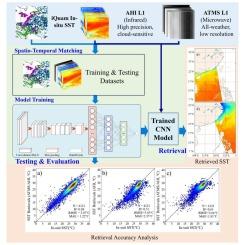弥合云的鸿沟:通过CNN特征融合的AHI/ATMS协同全天候海温检索
IF 8.6
Q1 REMOTE SENSING
International journal of applied earth observation and geoinformation : ITC journal
Pub Date : 2025-10-03
DOI:10.1016/j.jag.2025.104887
引用次数: 0
摘要
基于红外的海表温度(SST)检索方法面临着云引起的数据缺口和精度下降的持续挑战。本研究通过多传感器卫星协同,通过卷积神经网络(CNN)整合地球同步先进Himawari成像仪(AHI)和先进技术微波测深仪(ATMS)数据,以实现全天候海温检索,从而弥补了这一关键限制。CNN模型自适应提取多波段AHI/ATMS图像的特征,有效预测不同云条件下的海温。评估结果表明,测试数据集的均方根误差(RMSE)为2.07°C,平均绝对误差(MAE)为1.22°C,决定系数(R2)为0.88。在相同的CNN框架下,AHI和ATMS单峰检索的性能明显较低(R2 = 0.51, RMSE = 3.45°C; R2 = 0.63, RMSE = 2.64°C),证实了多传感器融合的互补优势。与基于transformer的模型、每日OSTIA产品和官方AHI SST产品(晴空条件)的比较进一步表明,所提出的CNN达到了最高的精度。虽然某些云类型的RMSE超过1°C,但该方法大大减轻了云引起的数据丢失,并为卫星海洋遥感提供了可靠、高精度、全天候的海温检索策略。本文章由计算机程序翻译,如有差异,请以英文原文为准。

Bridging the cloud gap: AHI/ATMS synergy through CNN feature fusion for all-weather SST retrieval
Infrared-based Sea Surface Temperature (SST) retrieval methods face persistent challenges from cloud-induced data gaps and accuracy degradation. This study bridges this critical limitation through multisensor satellite synergy, integrating geostationary Advanced Himawari Imager (AHI) with Advanced Technology Microwave Sounder (ATMS) data via a Convolutional Neural Network (CNN) for all weather SST retrieval. The CNN model adaptively extracts features from multi-band AHI/ATMS imagery, effectively predicting SST under varying cloud conditions. Evaluation results demonstrate a root mean square error (RMSE) of 2.07 °C, a mean absolute error (MAE) of 1.22 °C, and a coefficient of determination (R2) of 0.88 on the test dataset. Under the same CNN framework, unimodal retrievals from AHI and ATMS alone yield substantially lower performance (R2 = 0.51, RMSE = 3.45 °C; and R2 = 0.63, RMSE = 2.64 °C, respectively), confirming the complementary benefits of multisensor fusion. Comparisons with a Transformer-based model, the daily OSTIA product, and the official AHI SST product (clear-sky conditions) further indicate that the proposed CNN achieves the highest accuracy. Although RMSE exceeds 1 °C for certain cloud types, the method substantially mitigates cloud-induced data loss and provides a reliable, high-accuracy, all-weather SST retrieval strategy for satellite ocean remote sensing.
求助全文
通过发布文献求助,成功后即可免费获取论文全文。
去求助
来源期刊

International journal of applied earth observation and geoinformation : ITC journal
Global and Planetary Change, Management, Monitoring, Policy and Law, Earth-Surface Processes, Computers in Earth Sciences
CiteScore
12.00
自引率
0.00%
发文量
0
审稿时长
77 days
期刊介绍:
The International Journal of Applied Earth Observation and Geoinformation publishes original papers that utilize earth observation data for natural resource and environmental inventory and management. These data primarily originate from remote sensing platforms, including satellites and aircraft, supplemented by surface and subsurface measurements. Addressing natural resources such as forests, agricultural land, soils, and water, as well as environmental concerns like biodiversity, land degradation, and hazards, the journal explores conceptual and data-driven approaches. It covers geoinformation themes like capturing, databasing, visualization, interpretation, data quality, and spatial uncertainty.
 求助内容:
求助内容: 应助结果提醒方式:
应助结果提醒方式:


